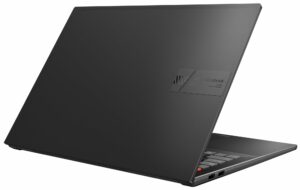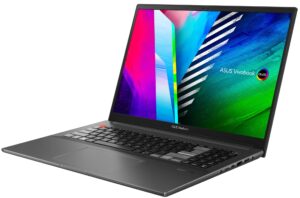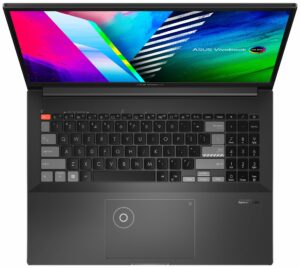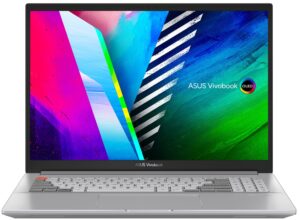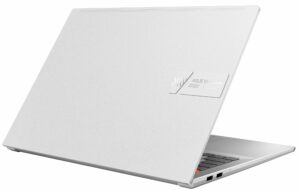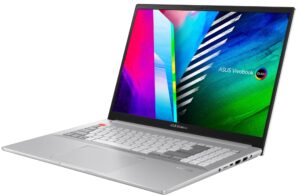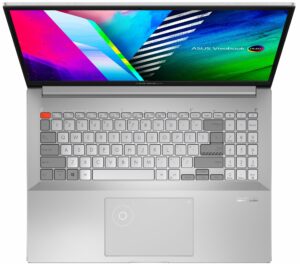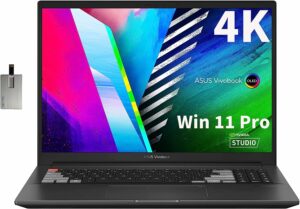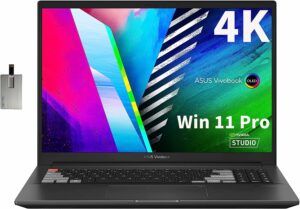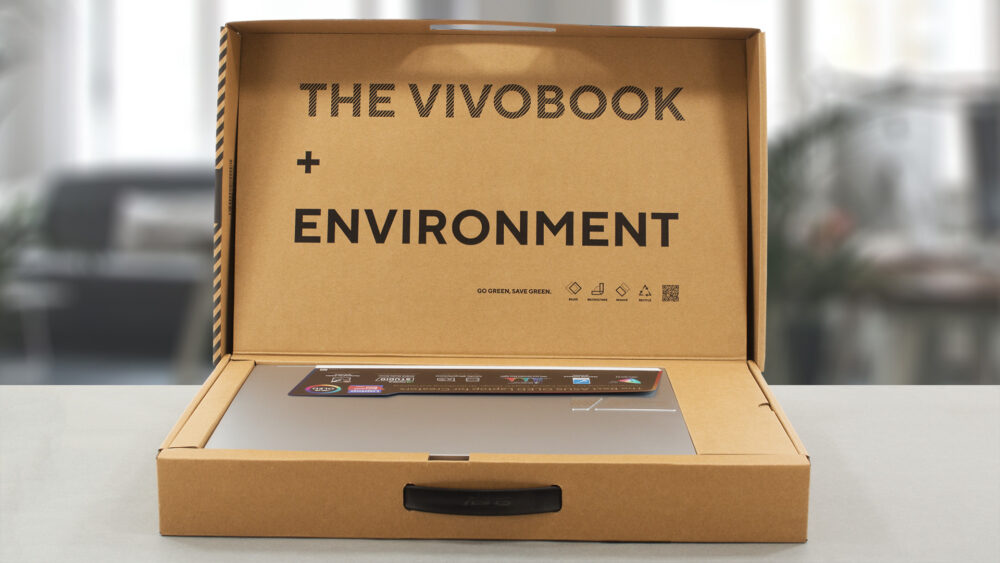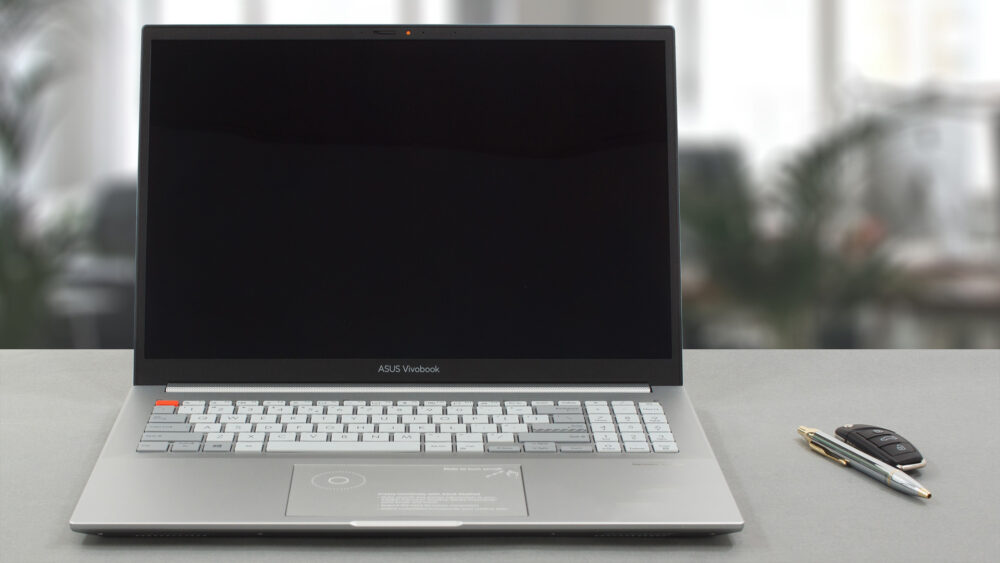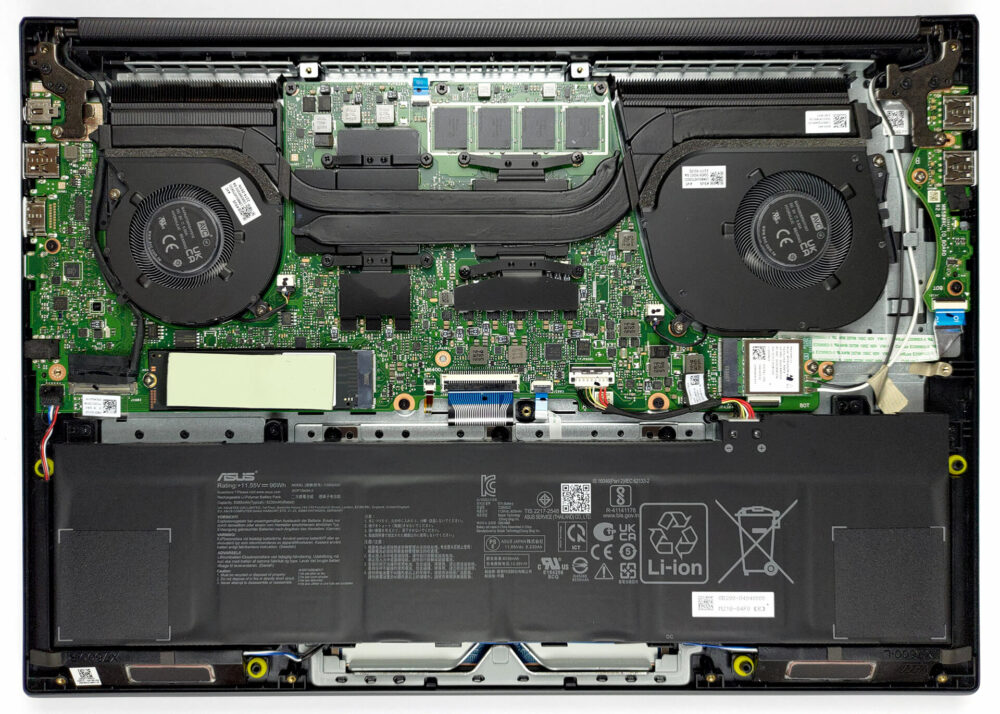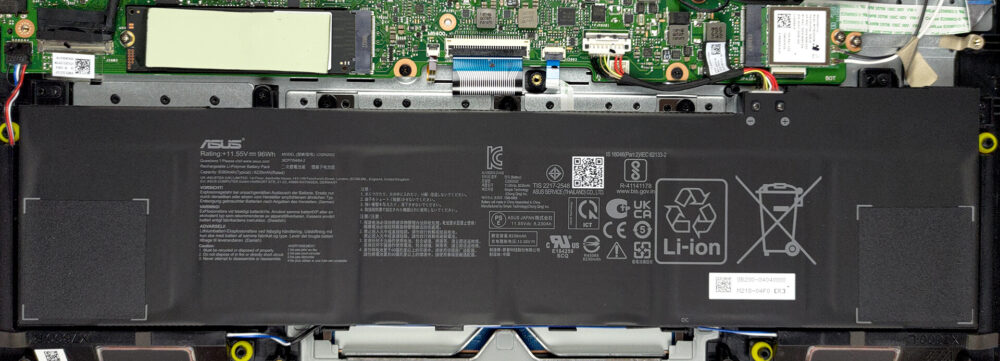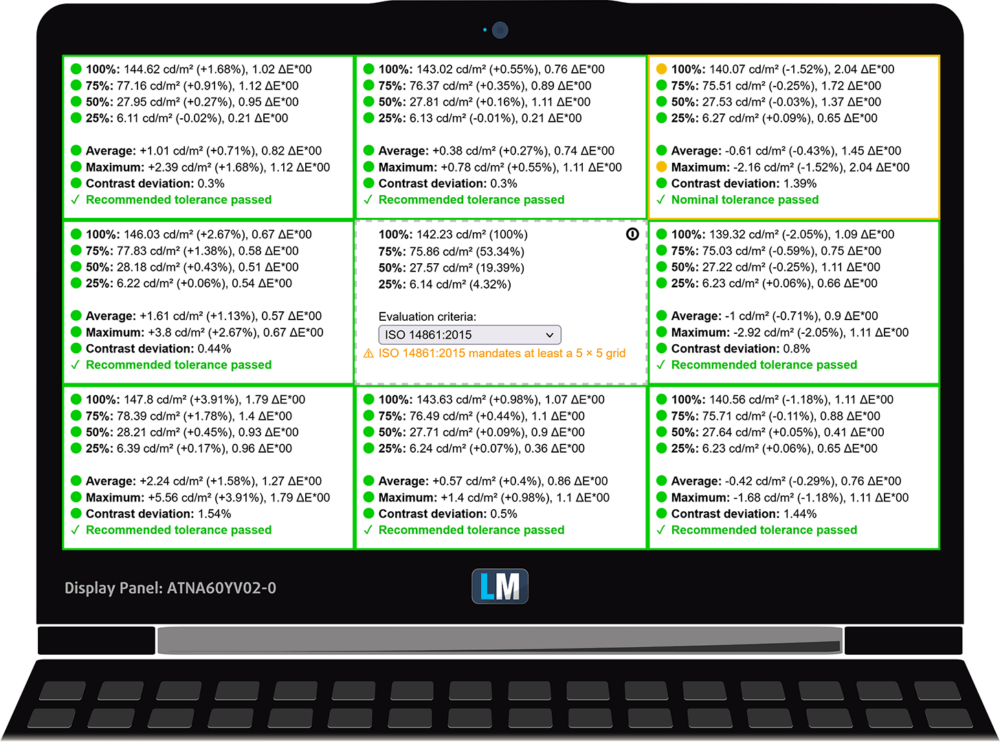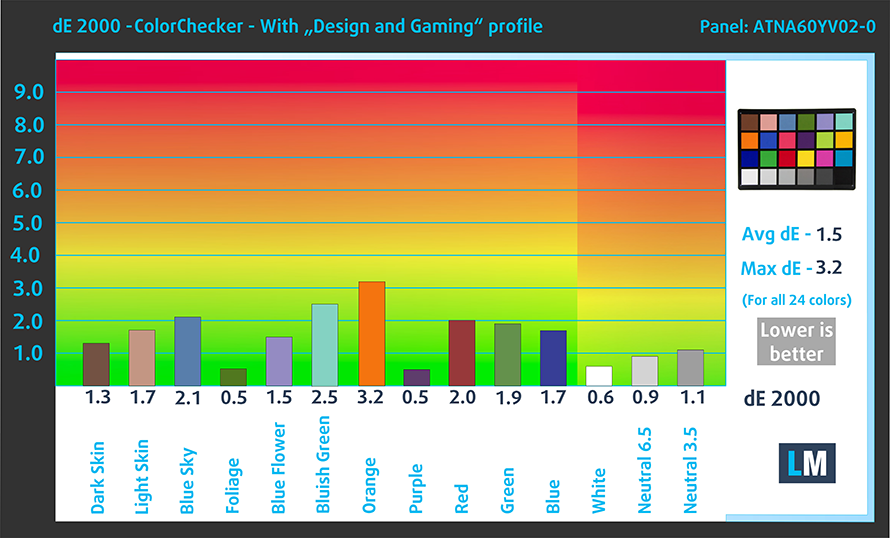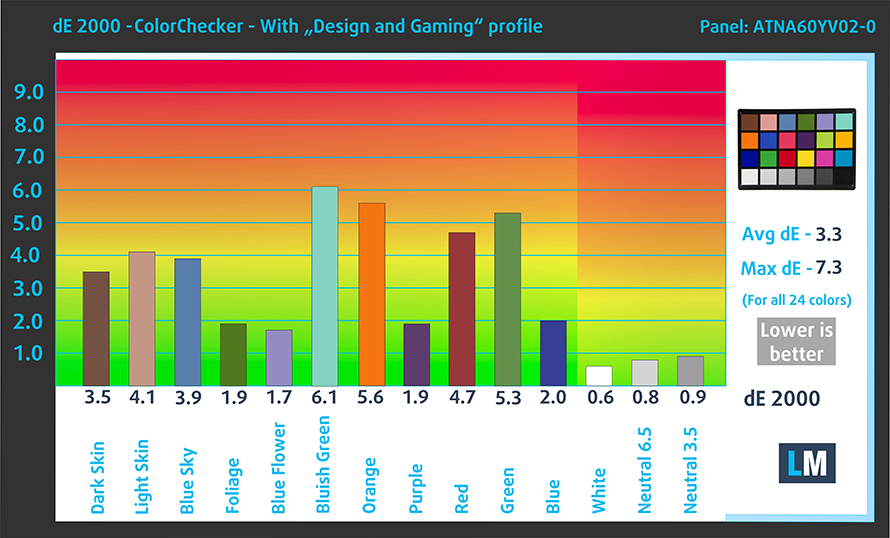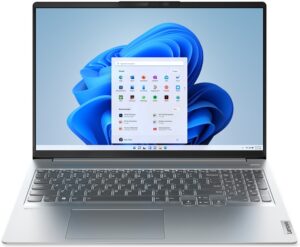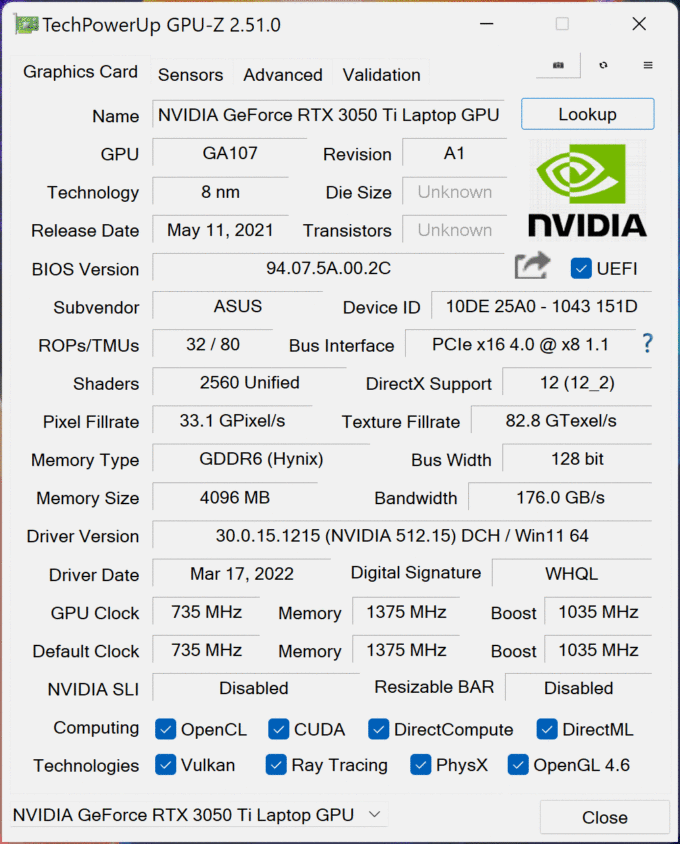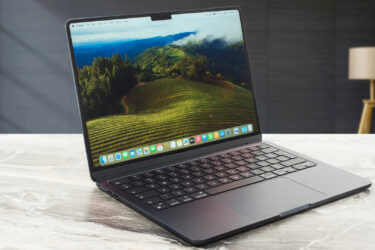ASUS Vivobook Pro 16X OLED (M7600) review – content creators will crave its efficiency
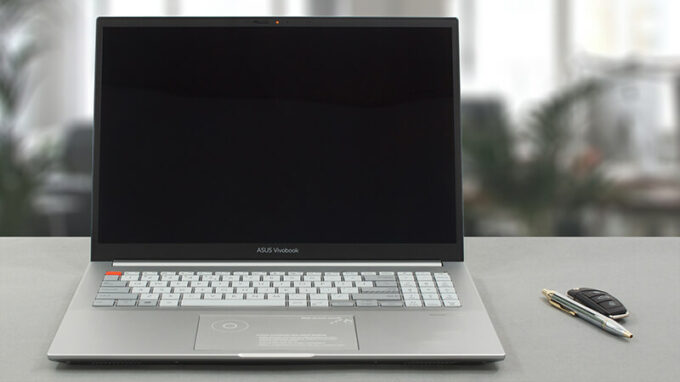 As you may know, the Vivobook is one of the most populous subbrands on the market. It comes in all kinds of shapes and form-factors. However, one of its most interesting iterations is the Vivobook Pro 16X OLED (M7600).
As you may know, the Vivobook is one of the most populous subbrands on the market. It comes in all kinds of shapes and form-factors. However, one of its most interesting iterations is the Vivobook Pro 16X OLED (M7600).
The models, which have an “M” before the final four numbers, come with AMD processors. In our case, the machine is fitted with Ryzen 6000H CPUs, which are among the most powerful options on the market right now.
In addition to that, ASUS gives you a 65W NVIDIA RTX 3050 Ti graphics card with Studio drivers. Ultimately, this means you can use the device for professional work, with even more confidence on the software side.
Now, there are a lot of reasons to consider this content-creator dream of a device. However, one of the biggest we can think of is the display. You get an OLED panel with a 4K resolution, 16:10 aspect ratio, HDR, Pantone Validated colors and more.
So, let’s take the laptop out of its box, and see what kind of surprises we get with it.
You can check the prices and configurations in our Specs System: https://laptopmedia.com/series/asus-vivobook-pro-16x-oled-m7600-amd-ryzen-6000-series/
Contents
- Specs Sheet
- What’s in the box?
- Design and construction
- Disassembly, upgrade options, and maintenance
- Display quality
- Health impact – PWM / Blue Light
- Buy our profiles
- Sound
- Drivers
- Battery
- CPU options
- GPU options
- Gaming tests
- [eBook Guide + Tools] How to MAX OUT your ASUS Vivobook Pro 16X OLED (M7600)
- Temperatures and comfort
- Verdict
Specs Sheet
- HDD/SSD
- up to 4000GB SSD
- M.2 Slot
- 1x 2280 PCIe NVMe 4.0 x4 See photo
- RAM
- up to 32GB
- OS
- Windows 11 Pro, Windows 11 Home
- Battery
- 96Wh, 6-cell
- Body material
- Aluminum
- Dimensions
- 360.5 x 259 x 18.9 mm (14.19" x 10.20" x 0.74")
- Weight
- 1.95 kg (4.3 lbs)
- Ports and connectivity
- 2x USB Type-A
- 2.0
- 1x USB Type-A
- 3.2 Gen 1 (5 Gbps)
- 1x USB Type-C
- 4.0, Power Delivery (PD), DisplayPort
- HDMI
- 2.1
- Card reader
- MicroSD
- Ethernet LAN
- Wi-Fi
- 802.11ax
- Bluetooth
- 5.0
- Audio jack
- 3.5mm Combo Jack
- Features
- Fingerprint reader
- Web camera
- HD with privacy shutter
- Backlit keyboard
- Microphone
- Array Microphone with Cortana and Alexa voice rec.
- Speakers
- Speakers System, Harman/Kardon
- Optical drive
- Security Lock slot
All ASUS Vivobook Pro 16X OLED (M7600, AMD Ryzen 6000 Series) configurations
What’s in the box?
Inside the package, you will find some paperwork, a small envelope with cool stickers, as well as a 150W power adapter.
Design and construction
Literally, the first thing that catches our eyesight is the design of the machine. It is incredibly sleek with the Vivobook logo embossed in the lid. There are two color choices – Black and Silver.
We found the lid a bit susceptible to flex, while the base is incredibly sturdy. You have to keep in mind that the entire thickness of the machine is only 18.9mm, while the weight reaches 2.00 kg – pretty fine, considering the 16-inch form factor.
Since this is one of the highest-level Vivobooks on the market, it is not a surprise that the lid can be opened with one hand in a smooth motion. The bezels around the glossy display are rather thin, with the top one featuring an HD Web camera with a privacy shutter above it.
Let’s take a quick look at the base, and see the backlit keyboard. It is a comfortable unit with decent key travel and relatively clicky feedback. As you can see, there is a NumberPad, as well as a Power button, that doubles as a fingerprint reader.
In addition, the function key shortcuts include a dedicated My ASUS button. But the arguably more impressive unit is found below the keyboard – namely the touchpad. As a regular touchpad, it performs pretty well – smooth texture, decent clicking mechanism, as well as accurate tracking.
What makes it different, however, is the DialPad functionality. It emulates shortcut Dials used by professionals to accelerate their professional workflow. The DialPad can be accessed by sliding the top-right part of the touchpad diagonally. It has good integration with most of the Adobe software, as well as other apps and programs. Furthermore, you can program it yourself, through the ProArt Creator Studio app.
Well, if you turn the laptop upside down, you probably won’t be as amazed, as with the touchpad. However, you will see the speaker cutouts and the ventilation grills. After the cool air enters the device through the bottom panel, it gets exhausted as hot air through two vents on the back of the base.
Ports
On the left side, you get two USB Type-A 2.0 ports. On the right, there is the charging plug, a USB Type-A 3.2 (Gen. 1) port, an HDMI 2.1 connector, a USB4 port with DisplayPort output, a MicroSD card slot, and an audio jack.
Disassembly, upgrade options, and maintenance
To access this notebook’s internals, you need to undo 11 Torx-head screws. Then, pry the bottom panel with a plastic tool, preferably starting from the front two corners.
Inside, we find a 96Wh battery pack. It lasts for 16 hours and 30 minutes of Web browsing, or 12 hours and 30 minutes of video playback. To remove it, unplug the battery connector, and undo all four Phillips-head screws that keep it attached to the chassis.
Here, the memory comes soldered to the motherboard. You can find configurations of the device with either 16 or 32GB of LPDDR5 RAM. Storage-wise, there is one M.2 PCIe x4 slot, which supports both Gen 3 and Gen 4 drives.
The cooling comprises a couple of heat pipes, connected to two heat sinks, and two fans. In addition, you can see some heat spreaders on top of the VRMs.
Display quality
ASUS Vivobook Pro 16X OLED (M7600) is equipped with an OLED panel, Samsung ATNA60YV02-0 (SDC415D). Its diagonal is 16.0-inch (40.6 cm), and the resolution – 3840 x 2400p. Additionally, the screen ratio is 16:10, the pixel density – 283 ppi, and their pitch – 0.09 x 0.09 mm. The screen can be considered Retina when viewed from at least 30 cm (from this distance, the average human eye can’t see the individual pixels).

Viewing angles are comfortable. We offer images at different angles to evaluate the quality.

Also, a video with locked focus and exposure.
The maximum measured brightness is 366 nits (cd/m2) in the middle of the screen (HDR off). The Correlated Color Temperature on a white screen and at maximum brightness is 7300K – colder than the 6500K optimal temperature for sRGB.
In the illustration below you can see how the display performs from a uniformity perspective.
Values of dE2000 over 4.0 should not occur, and this parameter is one of the first you should check if you intend to use the laptop for color-sensitive work (a maximum tolerance of 2.0 ). The contrast ratio here is incomparably better than that of the IPS and TN panels and is mathematically infinite.
To make sure we are on the same page, we would like to give you a little introduction to the sRGB color gamut and the Adobe RGB. To start, there’s the CIE 1976 Uniform Chromaticity Diagram that represents the visible specter of colors by the human eye, giving you a better perception of the color gamut coverage and the color accuracy.
Inside the black triangle, you will see the standard color gamut (sRGB) that is being used by millions of people on HDTV and on the web. As for the Adobe RGB, this is used in professional cameras, monitors, etc for printing. Basically, colors inside the black triangle are used by everyone and this is the essential part of the color quality and color accuracy of a mainstream notebook.
Still, we’ve included other color spaces like the famous DCI-P3 standard used by movie studios, as well as the digital UHD Rec.2020 standard. Rec.2020, however, is still a thing of the future and it’s difficult for today’s displays to cover that well. We’ve also included the so-called Michael Pointer gamut, or Pointer’s gamut, which represents the colors that naturally occur around us every day.
The yellow dotted line shows ASUS Vivobook Pro 16X OLED (M7600)’s color gamut coverage.
Its display covers 100% of the sRGB/ITU-R BT.709 (web/HDTV standard) in CIE1976 and 100% of DCI-P3 providing a punchy and vibrant image.

Our “Design and Gaming” profile delivers optimal color temperature (6500K) at 140 cd/m2 luminance and sRGB gamma mode.
We tested the accuracy of the display with 24 commonly used colors like light and dark human skin, blue sky, green grass, orange, etc. You can check out the results at factory condition and also, with the “Design and Gaming” profile.
Below you can compare the scores of ASUS Vivobook Pro 16X OLED (M7600) with the default settings (left), and with the “Gaming and Web design” profile (right), against the P3-D65 color space.
We also compared default settings and our “Gaming and Web design profile in the sRGB color space.
The next figure shows how well the display is able to reproduce really dark parts of an image, which is essential when watching movies or playing games in low ambient light.
The left side of the image represents the display with stock settings, while the right one is with the “Gaming and Web Design” profile activated. On the horizontal axis, you will find the grayscale, and on the vertical axis – the luminance of the display. On the two graphs below you can easily check for yourself how your display handles the darkest nuances but keep in mind that this also depends on the settings of your current display, the calibration, the viewing angle, and the surrounding light conditions.
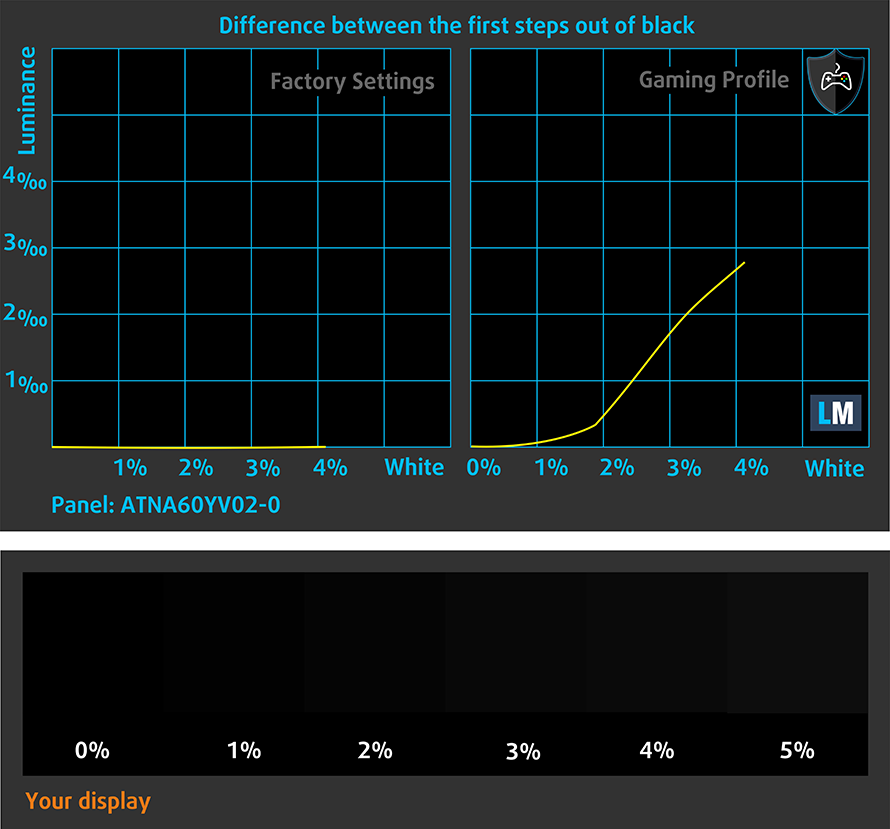
Response time (Gaming capabilities)
We test the reaction time of the pixels with the usual “black-to-white” and “white-to-black” method from 10% to 90% and vice versa.
We recorded Fall Time + Rise Time = 2 ms – insane speed.
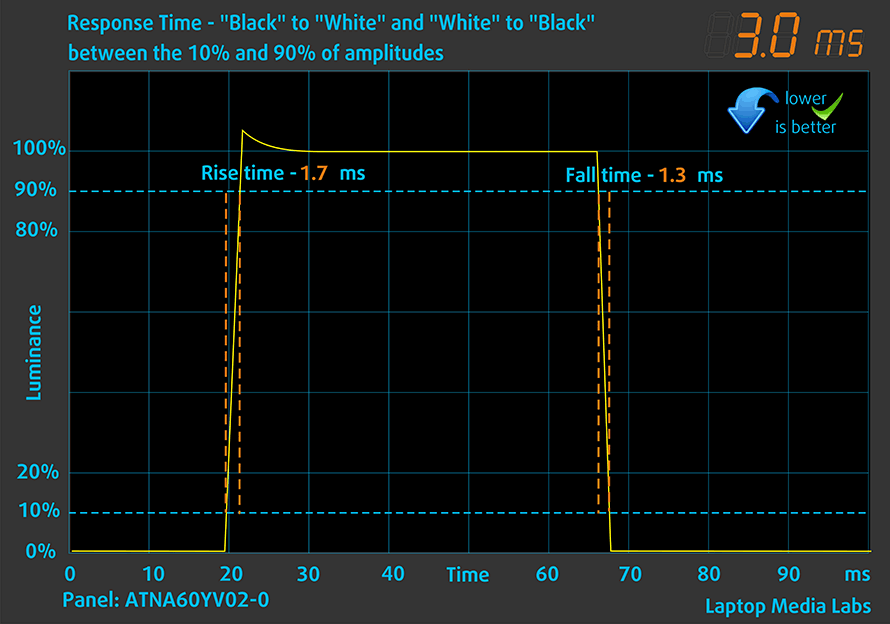
After that, we test the reaction time of the pixels with the usual “Gray-to-Gray” method from 50% White to 80% White and vice versa between 10% and 90% of the amplitude.
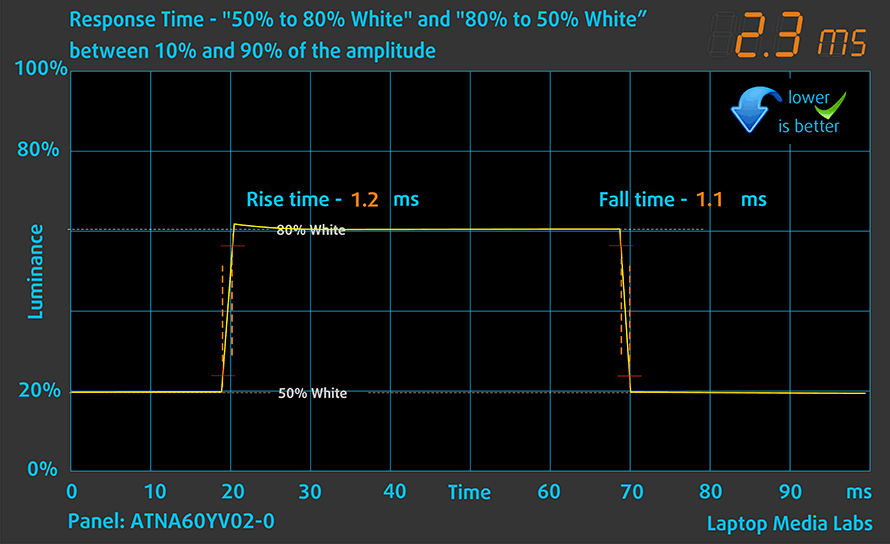
Health impact – PWM / Blue Light
PWM (Screen flickering)
Pulse-width modulation (PWM) is an easy way to control monitor brightness. When you lower the brightness, the light intensity of the backlight is not lowered, but instead turned off and on by the electronics with a frequency indistinguishable to the human eye. In these light impulses, the light/no-light time ratio varies, while brightness remains unchanged, which is harmful to your eyes. You can read more about that in our dedicated article on PWM.
Unfortunately, ASUS Vivobook Pro 16X OLED (M7600)’s panel uses low-frequency PWM for brightness adjustment up until 110 nits. Afterwards, we detected small pulsations, which makes the display relatively safe in this aspect (after 110 nits). The My ASUS app features a neat function, called “Flicker-Free Dimming”, which completely eliminates the PWM issue.
Blue light emissions
Installing our Health-Guard profile not only eliminates PWM but also reduces the harmful Blue Light emissions while keeping the colors of the screen perceptually accurate. If you’re not familiar with the Blue light, the TL;DR version is – emissions that negatively affect your eyes, skin, and your whole body. You can find more information about that in our dedicated article on Blue Light.
Gloss level measurement
Glossy-coated displays are sometimes inconvenient in high ambient light conditions. We show the level of reflection on the screen for the respective laptop when the display is turned off and the measurement angle is 60° (in this case, the result is 156 GU).

Buy our profiles
Since our profiles are tailored for each individual display model, this article and its respective profile package are meant for ASUS Vivobook Pro 16X OLED (M7600) configurations with 16.0″ Samsung ATNA60YV02-0 (SDC415D) (3840 x 2400p) AMOLED panel.
*Should you have problems with downloading the purchased file, try using a different browser to open the link you’ll receive via e-mail. If the download target is a .php file instead of an archive, change the file extension to .zip or contact us at [email protected].
Read more about the profiles HERE.
In addition to receiving efficient and health-friendly profiles, by buying LaptopMedia's products you also support the development of our labs, where we test devices in order to produce the most objective reviews possible.

Office Work
Office Work should be used mostly by users who spend most of the time looking at pieces of text, tables or just surfing. This profile aims to deliver better distinctness and clarity by keeping a flat gamma curve (2.20), native color temperature and perceptually accurate colors.

Design and Gaming
This profile is aimed at designers who work with colors professionally, and for games and movies as well. Design and Gaming takes display panels to their limits, making them as accurate as possible in the sRGB IEC61966-2-1 standard for Web and HDTV, at white point D65.

Health-Guard
Health-Guard eliminates the harmful Pulse-Width Modulation (PWM) and reduces the negative Blue Light which affects our eyes and body. Since it’s custom tailored for every panel, it manages to keep the colors perceptually accurate. Health-Guard simulates paper so the pressure on the eyes is greatly reduced.
Get all 3 profiles with 33% discount
Sound
ASUS Vivobook Pro 16X OLED (M7600)’s Harman Kardon speakers produce a sound of very good quality. Not only that, but its low, mid, and high tones are clear of deviations.
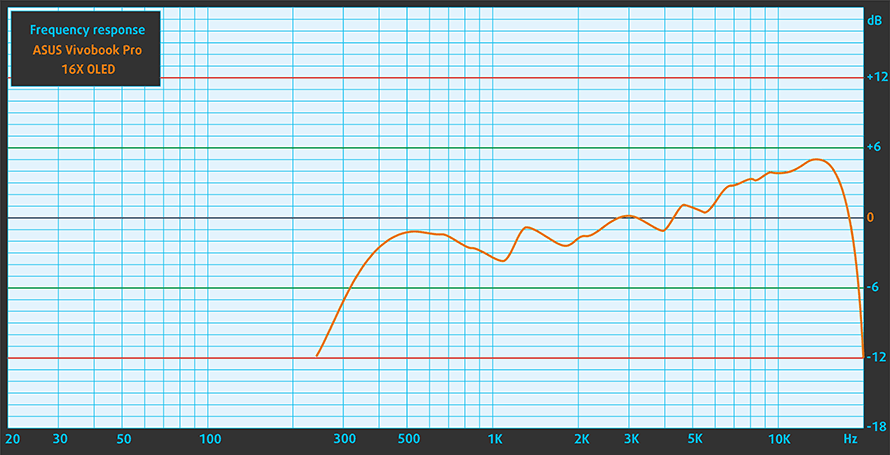
Drivers
All drivers and utilities for this notebook can be found here: https://www.asus.com/laptops/for-creators/vivobook/vivobook-pro-16x-oled-m7600-amd-ryzen-6000-series/helpdesk_download/
Battery
Now, we conduct the battery tests with the Windows Better performance setting turned on, screen brightness adjusted to 120 nits, and all other programs turned off except for the one we are testing the notebook with. This device’s huge 96Wh battery pack lasts for 16 hours and 29 minutes of Web browsing, or 12 hours and 24 minutes of video playback.
In order to simulate real-life conditions, we used our own script for automatic web browsing through over 70 websites.
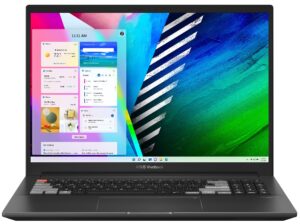
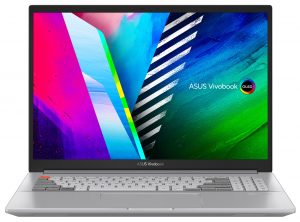
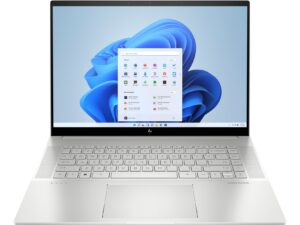
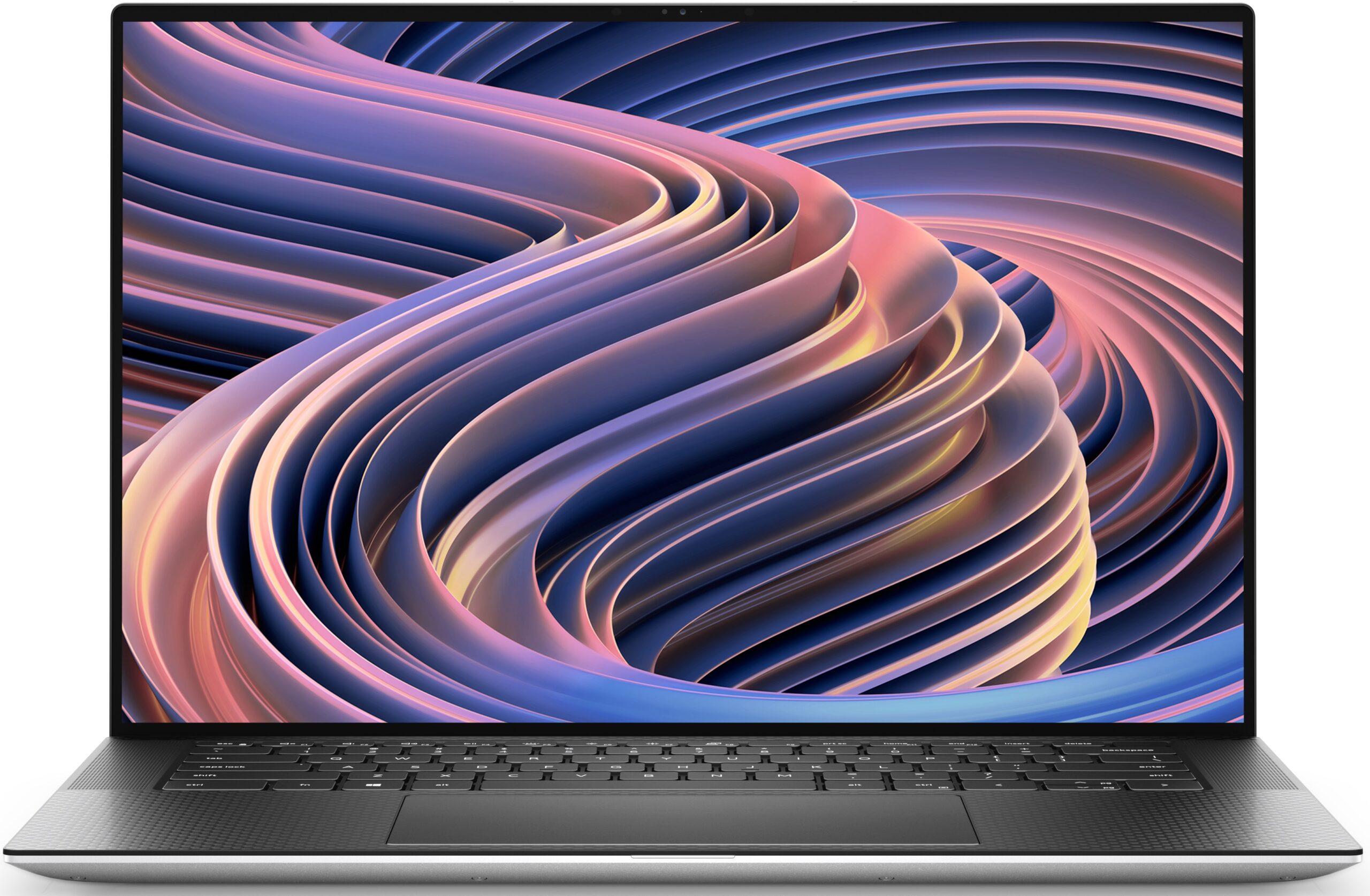

For every test like this, we use the same video in HD.





CPU options
You can find this laptop equipped with the Ryzen 7 6800HS, Ryzen 7 6800H, or Ryzen 9 6900HX.
Results are from the Cinebench R23 CPU test (the higher the score, the better)
Results are from our Photoshop benchmark test (the lower the score, the better)
GPU options
In addition to the integrated graphics, the Vivobook Pro 16X OLED (M7600) comes with an RTX 3050 Ti (65W) with 4GB of GDDR6 VRAM.
Results are from the 3DMark: Time Spy (Graphics) benchmark (higher the score, the better)
Results are from the 3DMark: Fire Strike (Graphics) benchmark (higher the score, the better)
Results are from the 3DMark: Wild Life benchmark (higher the score, the better)
Results are from the Unigine Superposition benchmark (higher the score, the better)
Gaming tests
| Metro Exodus | Full HD, Low (Check settings) | Full HD, High (Check settings) | Full HD, Extreme (Check settings) |
|---|---|---|---|
| Average FPS | 102 fps | 47 fps | 22 fps |
| Borderlands 3 | Full HD, Medium (Check settings) | Full HD, High (Check settings) | Full HD, Badass (Check settings) |
|---|---|---|---|
| Average fps | 83 fps | 60 fps | 46 fps |

| Shadow of the Tomb Raider (2018) | Full HD, Lowest (Check settings) | Full HD, Medium (Check settings) | Full HD, High (Check settings) |
|---|---|---|---|
| Average | 105 fps | 76 fps | 71 fps |
| Tom Clancy’s Ghost Recon Wildlands | Full HD, Medium (Check settings) | Full HD, High (Check settings) | Full HD, Very High (Check settings) |
|---|---|---|---|
| Average fps | 82 fps | 75 fps | 64 fps |
[eBook Guide + Tools] How to MAX OUT your ASUS Vivobook Pro 16X OLED (M7600)
Your ASUS Vivobook Pro 16X OLED (M7600) can be Faster. LaptopMedia has tested thousands of models in the last 15 years, and we’re yet to see a notebook that couldn’t be made more powerful through modifications. And have you seen the most popular search on Google related to “how to make my …”? No? OK, here it is:

As you see, having a faster laptop is more important than having more hair.
Well, the main issue here is that there are thousands of advices on the Web. Some work, some don’t. Some are easy, some are complicated. Some are safe, and some are risky. If only there could be an Easy-to-Follow, Step-by-Step, and Laboratory-Tested guide by a proven organization, right?
That’s what we’ve done. We have hundreds of laptops scattered in our office, and we’ve spent a whole year testing different optimizations. We’ve chosen the ones that really make a difference, that are easy to implement without expert skills, and that are safe for your laptop in the long term.

🚀 What’s the performance boost I could expect?
There’s no general answer but we’ve reached more than 30% GPU Performance boost on some models, while typically it’s between 10% and 20%. You could always go beyond but we want to be sure that our advice will keep your laptop on the safe side in the long term. But you want to get the absolute maximum? We’ll show you how, and then it’s up to you.
We even set several World Records on 3DMark, one being our first Max Out for a specific laptop model – MSI Katana B13V.
We’d be happy to compete with YOU on the 3DMark rank lists, and see what YOUR laptop can do using our guide!
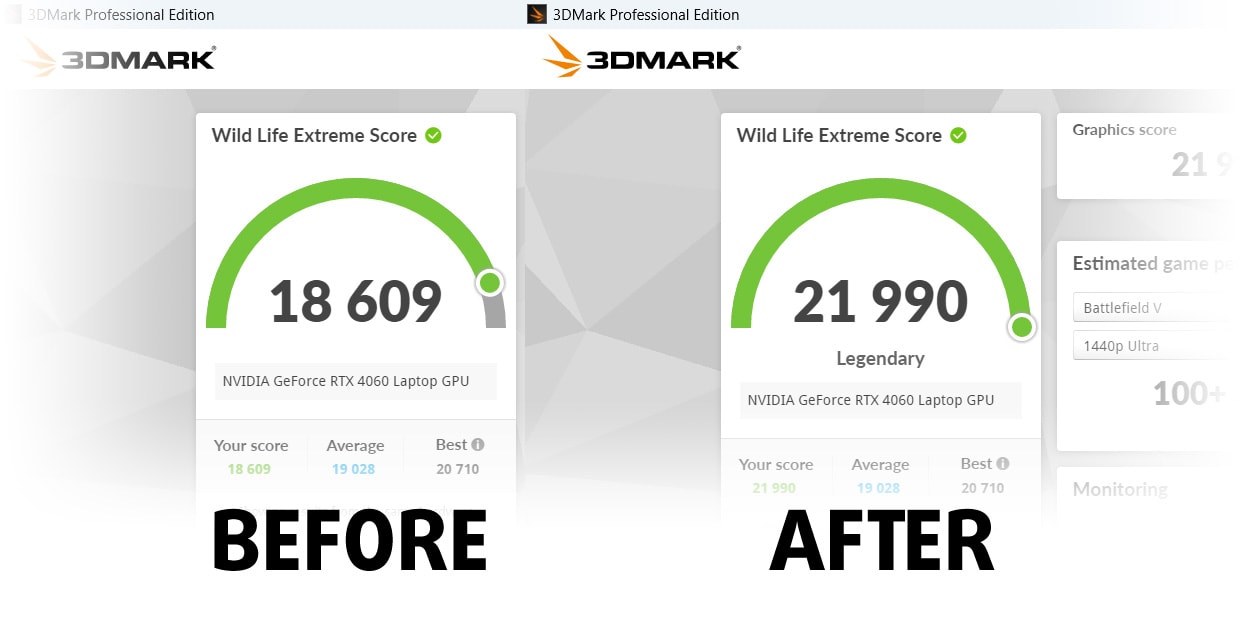
📦 What’s included?
📖 Our eBook includes All the tools you need, along with an Easy-to-follow guide for hassle-free:
⚡ GPU Performance boost by vBIOS replacement, Overclocking, and Undervolting
⚙️ Checking the hardware components and finding if you could get a significant boost by upgrading some of them
💾 Installing a clean Windows OS, with all the base settings you need
📋 Software optimization steps that really give a performance boost
⏩ Building a RAID Storage configuration for doubling sequential read/write speeds or protecting your data
🎯 Display Profiles bundle for a panel of your choice, enhancing the display for accurate colors, better experience, and protection of your eyes
🎁 To receive the Display Profiles bundle as a gift, simply email us your panel model through our “Contact Us” form.
💵 What is the price?
R&D on laptops isn’t easy nor cheap, especially when you’re not using cherry-picked review samples but real units instead. Our idea is to reinvest the profits from the sales back in our laboratory. However, we also want to make it a killer deal for everyone who is planning or has already spent on a gaming laptop, as this product would significantly boost the performance per dollar they get.

🛠️ GPU Modifications: vBIOS, Overclocking, Undervolting
⚙️ Building Fast/Reliable RAID configuration
💻 Hardware upgrade tips for best results
🖼 Display enhancing
💾 OS Optimization for best performance
✖ But if these optimizations are easy, why don’t manufacturers do them?
There are a lot of reasons for the manufacturers to put boundaries on your machine, locking part of its performance:
📊 Market Segmentation: To create different product tiers, manufacturers often limit performance. This allows them to target various market segments and price points, encouraging consumers to pay more for higher-performing models.
❓Unknown Potential: Each unit’s performance varies. Checking each one individually isn’t feasible.
🏢 Regulatory Compliance: Certain regions have regulations regarding energy consumption, and manufacturers often place some boundaries to fit all standards.
🏭 Supply Chain Constraints: Limitations are imposed due to the current availability of components.
🫰 Cost-effective solutions: Often, less popular but important details are overlooked. For example, better RAM types can boost performance by up to 30%, but many users ignore this, and many online stores don’t even provide that info.
🔒 Security concerns: Many protections impact performance while being negligible for regular users. However, manufacturers don’t know if their laptops will be purchased by individuals or large corporations, so they can’t disable these features by default.
Not a bad performance bump in terms of Storage Speeds:
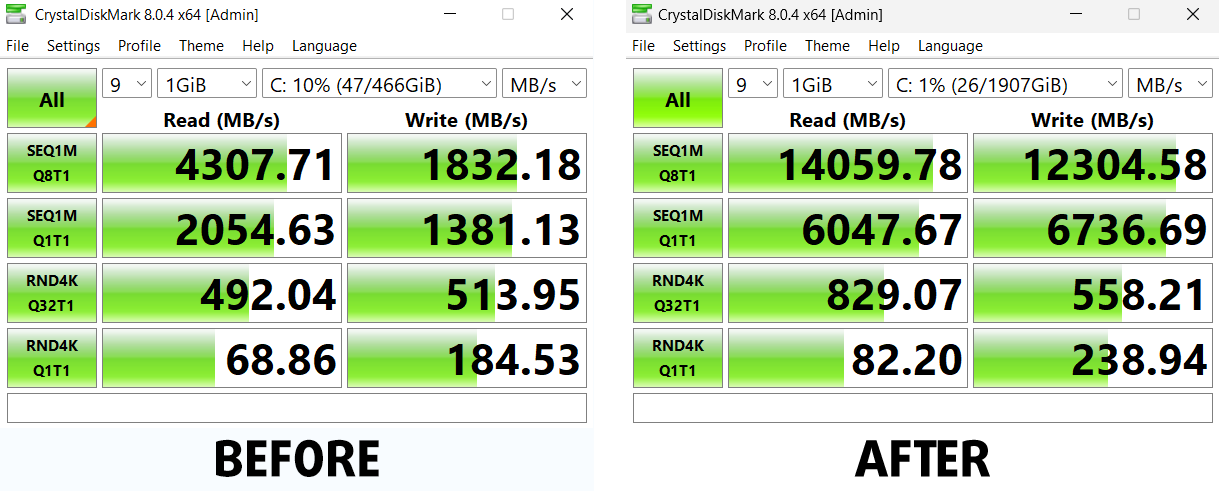
What are the default apps that impact performance the most?
What to do when RAID drives don’t show up?
How to optimize Windows further for maximum FPS gain in games?

Temperatures and comfort
Max CPU load
In this test we use 100% on the CPU cores, monitoring their frequencies and chip temperature. The first column shows a computer’s reaction to a short load (2-10 seconds), the second column simulates a serious task (between 15 and 30 seconds), and the third column is a good indicator of how good the laptop is for long loads such as video rendering.
Average core frequency (base frequency + X); CPU temp.
| AMD Ryzen 9 6900HX (45W TDP) | 0:02 – 0:10 sec | 0:15 – 0:30 sec | 10:00 – 15:00 min |
|---|---|---|---|
| ASUS Vivobook Pro 16X OLED (M7600) | 3.67 GHz @ 91°C @ 65W | 3.66 GHz @ 95°C @ 64W | 3.54 GHz @ 83°C @ 54W |
Although we have nothing to compare it with, the Vivobook Pro 16X OLED (M7600) shows promising performance. It retains its clock speed throughout the entire test within a difference of 130 MHz.
Real-life gaming
| NVIDIA GeForce RTX 3050 Ti | GPU frequency/ Core temp (after 2 min) | GPU frequency/ Core temp (after 30 min) | GPU frequency/ Core temp (Max fan) |
|---|---|---|---|
| ASUS Vivobook Pro 16X OLED (M7600) | 1630 MHz @ 82°C @ 59W | 1598 MHz @ 86°C @ 59W | – |
| ASUS Vivobook Pro 14X OLED (N7401) | 1577 MHz @ 69°C @ 50W | 1586 MHz @ 66°C @ 50W | – |
| Dell G15 5520 | 1802 MHz @ 73°C @ 90W | 1800 MHz @ 74°C @ 90W | – |
| Dell Vostro 16 7620 | 1631 MHz @ 76°C @ 63W | 1602 MHz @ 84°C @ 63W | – |
| ASUS Zenbook Pro 14 Duo OLED (UX8402) | 1701 MHz @ 80°C @ 64W | 1694 MHz @ 82°C @ 63W | – |
| Dell XPS 15 9520 | 1168 MHz @ 74°C @ 30W | 1380 MHz @ 75°C @ 38W | – |
| Dell XPS 15 9510 | 1187 MHz @ 74°C @ 40W | 1293 MHz @ 75°C @ 44W | – |
| Microsoft Surface Laptop Studio | 1610 MHz @ 73°C @ 49W | 1629 MHz @ 70°C @ 50W | – |
| ASUS ROG Flow Z13 (GZ301) | 1299 MHz @ 62°C @ 40W | 1285 MHz @ 62°C @ 40W | – |
| Lenovo ThinkBook 15p Gen 2 | 1539 MHz @ 69°C @ 50W | 1536 MHz @ 69°C @ 50W | – |
| HP Omen 16 (16-b0000) | 1781 MHz @ 68°C @ 80W | 1767 MHz @ 71°C @ 80W | – |
| HP Envy 15 (15-ep1000) | 1681 MHz @ 87°C @ 75W | 1376 MHz @ 74°C @ 48W | – |
| ASUS ZenBook Pro 15 OLED (UM535) | 1530 MHz @ 66°C @ 50W | 1529 MHz @ 68°C @ 50W | – |
| HP Pavilion Gaming 15 (15-dk2000) | 1613 MHz @ 65°C @ 60W | 1576 MHz @ 73°C @ 60W | – |
| MSI Sword 15 | 1633 MHz @ 73°C @ 60W | 1605 MHz @ 79°C @ 60W | 1644 MHz @ 69°C @ 60W |
| Dell G15 5511 | 1882 MHz @ 71°C @ 88W | 1878 MHz @ 72°C @ 89W | – |
| Dell G15 5515 | 1857 MHz @ 76°C @ 80W | 1850 MHz @ 77°C @ 80W | – |
| Acer Nitro 5 (AN515-57) | 1616 MHz @ 70°C @ 66W | 1607 MHz @ 72°C @ 65W | 1632 MHz @ 69°C @ 66W |
| MSI Katana GF76 | 1619 MHz @ 76°C @ 60W | 1594 MHz @ 82°C @ 60W | 1632 MHz @ 70°C @ 60W |
Well, this is a bit weird. Unfortunately, the Vivobook Pro 16X OLED (M7600) can’t keep up with its GPU’s 65W TGP. In addition to that, it runs at temperatures, which are pretty hot.
Gaming comfort
This, respectively, makes the fans go vroom. On the other hand, we’ve definitely experienced far worse situations. And on the outside, the keyboard hotspot is within a reasonable range. Again, the bottom panel gets pretty warm, since there is little to isolate the heat from the metal bottom panel.
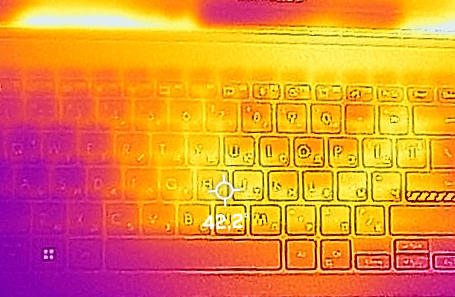
Verdict
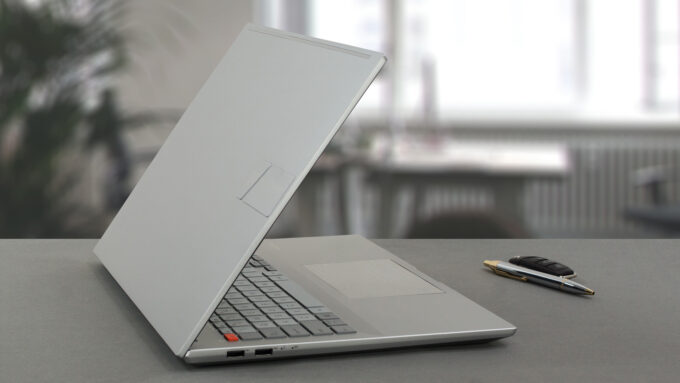 Drawing a conclusion on this device is especially difficult. For something that appeared to be a no-brainer specs-wise, we have some questions that settled in once we ran the Vivobook Pro 16X OLED (M7600) through its paces.
Drawing a conclusion on this device is especially difficult. For something that appeared to be a no-brainer specs-wise, we have some questions that settled in once we ran the Vivobook Pro 16X OLED (M7600) through its paces.
Generally, the processor shows a decent performance for a laptop of this class. However, it doesn’t really perform better than even the last-gen Ryzen devices. The same can be said about the graphics card, which was no better than that of the 14-inch Intel iteration of the Vivobook Pro. More so, the 16X has a 15W advantage in terms of TGP.
This means one thing – ASUS could have done a better job in the cooling department. Actually, it didn’t do anything in particular, as it transferred the same solution from last year’s model. And there is space inside.
Now, we have to say that all that we just said will make very little difference in day-to-day workflow. In fact, there are things that will make a bigger impact on the perceived speed of the notebook.
One of them is the support for Gen 4 SSDs, and the USB4 connector, which allows for 40Gbps connections. Plus, it supports DisplayPort and Power Delivery functions. However, you should keep in mind that the memory here is soldered to the motherboard.
Despite the lack of potential upgrades, you can find the device with either 16GB or 32GB of RAM. What makes the bigger difference in productivity is its LPDDR5 RAM.
ASUS Vivobook Pro 16X OLED (M7600)’s OLED display has a 4K resolution, high maximum brightness, and comfortable viewing angles. Additionally, it offers really fast pixel response times, as well as deep blacks. The latter is because each pixel can turn itself off, practically resulting in zero illumination in this area.
Moreover, this unit covers 100% of the sRGB and DCI-P3 color gamuts, which results in a very punchy image. On the downside, we saw a rather aggressive PWM usage below 110 nits. On the bright side, ASUS has designed a feature for the My ASUS app, which eliminates all PWM – it is called “Flicker-Free Dimming”.
One of the main reasons to consider this notebook, more than others in its class, is the DialPad. It transforms the touchpad into a virtual knob, which gives you finer control over things like timeline scrubbing, settings adjustment, volume control, and more. Plus, you look like a DJ, while doing it.
By the way, we found it hard to believe how long this laptop’s battery lasts. Yes, it is a 96Wh unit, but it has to power a 4K OLED panel. Nevertheless, it got us through 16 hours and 30 minutes of Web browsing, or 12 hours and 30 minutes of video playback.
So, are you willing to trade some performance on the table for efficiency? And can you take advantage of the MicroSD card slot, and the USB4 connector? If yes, the Vivobook Pro 16X OLED (M7600) may become your favorite electronic device. And yes, of course, this machine comes with ASUS’ notorious noise-cancellation technology.
You can check the prices and configurations in our Specs System: https://laptopmedia.com/series/asus-vivobook-pro-16x-oled-m7600-amd-ryzen-6000-series/
Pros
- Fantastic battery life
- Strong aluminum chassis
- 100% sRGB and DCI-P3 coverage + HDR support
- High resolution and 16:10 aspect ratio + fast pixel response times
- Deep blacks and virtually infinite contrast ratio
- DialPad + fingerprint reader
- USB4 + MicroSD card slot
Cons
- Uses PWM below 110 nits (fixed by the My ASUS app)
- 2 out of 3 USB Type-A ports run at 2.0 speeds
- Soldered memory



